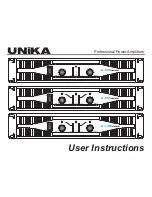
Installation
ComTec GmbH
4-1
4.
Installation
4.1. Noise Consideration
The preamplifier components associated with the detector bias (HV) have been scientifically
cleaned. This process removes all residues and fingerprints which could cause excessive noise
and possible failure of the preamplifier when high voltage is applied. It is strongly recommended
that causion be exercised never to touch these components nor have them exposed to the
atmosphere without the preamplifier case, for any long duration.
Any capacitance added to the input of the preamplifier will increase the noise contribution and
degrade the rise time performance of the Model CSP10…13. The capacitance should be
minimized by using the shortest possible interconnecting cable between the detector and the
preamplifier.
The detector load resistance R is normally 100 megaohms. If silicon surface barrier detectors are
used whose leakage current is greater than 1 microamp, the voltage drop across the resistor
must be allowed for, or alternatively, the value of R reduced to provide an voltage drop. The latter
will cause the 0 pF noise of the preamplifier to increase, but this will usually be insignificant
compared to the noise generated in the detector by the increased leakage current. Do not reduce
R below 10 megaohms without contacting the factory.
4.2. Detector Bias
The Model CSP1X-4S Preamplifier HV Input accepts up to ± 4000 VDC from the detector bias
supply. Never connect or disconnect the preamplifier from a detector while the high voltage is on.
Always wait at least one minute after the detector bias has been reduced to zero bevor
disconnecting the preamplifier from the detector. Maximum stability of the preamplifier is
maintained 60-90 seconds after preamplifier power and high voltage is applied.
The Model CSP1X-2S has a larger input coupling capacitor (10 nF) for detectors with high
capacity . If the maximum detector bias is below 1000V, the Model CSP1X-1B is the right choice.
The input connector and the HV bias connector is BNC. It is usually more convenient to use BNC,
because these connectors are much more common.
For Vacuum applications, the feed through connector is in many cases only available as BNC.


































